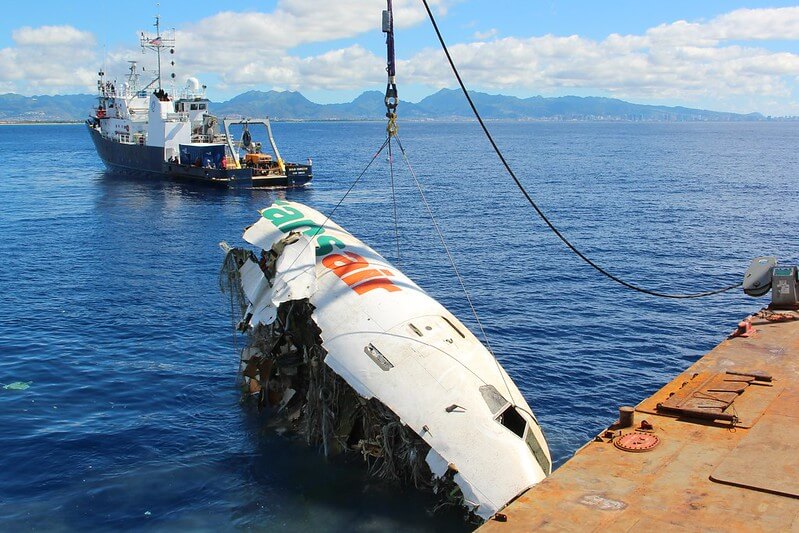Accident investigators have recovered the flight recorders and all major parts of a TransAir Boeing 737 cargo jet that ditched into the Pacific Ocean near Honolulu.
The crew of TransAir Flight 810 reported problems with both engines shortly after takeoff from Daniel K Inouye International Airport (HNL) at about 0145 local time on July 2, 2021. The cargo flight was headed for Kahului International Airport (OGG) in Hawaii.
The two pilots, the sole occupants of the aircraft, landed the aircraft on the water and were able to escape. The aircraft wreckage then sank, resting on an ocean shelf at a depth of around 350-450 feet (100-140 meters).
A recovery operation was launched on October 12, 2021 with the Bold Horizon research vessel, which includes a remotely operated vehicle (ROV) and other underwater retrieval equipment, and a barge to lift sections of the plane and transport them to shore.
Since then, the engines, landing gear, fuselage, cargo and other components have been retrieved, the National Transportation Safety Board, which is leading the investigation, said on November 2, 2021.
“The recovery of the recorders and virtually the entire airplane represents a major step forward in the investigation,” NTSB Chair Jennifer Homendy said in the statement.
The cockpit voice recorder and flight data recorder, known as the black boxes, are crucial items in any air crash investigation and will provide vital clues to understanding what went wrong with the TransAir flight.
SALVAGING THE WRECKAGE
An underwater survey of the accident site in July showed that the fuselage had broken into two pieces, comprising the aft section with the wings and tail and a forward section housing the cockpit. Both engines came away from the wings at impact, as did the forward landing gear assembly.
The forward section of the fuselage, measuring approximately 37 feet (11.2 meters) long and weighing about 15,500 pounds (7,030 kilograms), was moved to the barge on October 20 and brought to shore in Hawaii on Oct. 22, the NTSB explained.
The aft section of the fuselage, which was much bigger at some 63 feet (19.2 meters) long and 60,500 pounds (27,400 kilograms) including cargo containers, was more challenging to retrieve. The wings and tail had to be secured so they would not detach during the process to lift it out of the water. It was placed on the barge on October 30, 2021 and brought to shore on October 31.
“We are so appreciative of the collaborative efforts of the federal and state agencies, parties and contractors that contributed to this successful outcome,” the NTSB’s Homendy added.
The black boxes will now be taken to the NTSB lab in Washington, where they will be cleaned and dried and the data downloaded and analyzed.
The two sections of the fuselage will be examined by investigators in Hawaii, while the engines will be sent to the mainland and taken apart under the supervision of an investigator.
The NTSB expects the investigation will be complete in 12-24 months.
